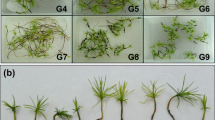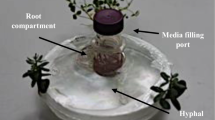Abstract
Normal pods (containing seed) of groundnut (Arachis hypogaea L.) (cv. TMV-2) were successfully raised in darkened, aerated, nutrient solution, but not in the light. The onset of podding was evident 7 to 8 d after gynophores were submerged in the darkened nutrient solution. An examination of pods and submerged portions of gynophore surfaces by scanning electron microscopy showed the presence of two distinctly different protuberances: unicellular root-hair-like structures that first developed from epidermal cells of the gynophores and developing pods; and branched septate hairs that developed later from cells below the epidermal layer. The septate hairs became visible only after the epidermal and associated unicellular structures had been shed by the expanding gynophore and pods. Omission of Mn and Mg from the podding environment increased pod and seed weight, whilst omission of Zn reduced pod and seed weight.
Similar content being viewed by others
References
Bledsoe R W, Comar C L and Harris H C 1949. Absorption of radioactive calcium by peanut fruits. Science 109, 329–330.
Brady D J 1992. Effects of aluminium on early growth and nodulation of soybean and peanut. Ph.D Thesis, Univ. Queensland, Brisbane, Australia.
Brady N C and Colwell W E 1945. Yield and quality of large-seeded type peanuts as affected by potassium and certain combinations of potassium, magnesium and calcium. J. Am. Soc. Agron. 37, 429–442.
Campbell L C, Miller M H and Loneragan J F 1975. Translocation of boron to plant fruits. Aust. J. Plant Physiol. 2, 481–487.
Chesney H A D 1975. Fertiliser studies with groundnuts on the brown sands of Guyana. 1. Effect of nitrogen inoculum, magnesium, and fritted micronutrients. Agron. J. 67, 7–10.
Colwell W E and Brady N C 1945. The effect of calcium on yield and quality of large-seeded type peanuts. J. Am. Soc. Agron. 37, 413–428.
Waldron R A 1919. The peanut, its history, histology, physiology, and utility. Contr. Bot. Lab. Univ. Pennsylvania 4, 302–338.
Zamski E and Ziv M 1976. Pod formation and its geotropic orientation in peanut, Arachis hypogaea L., in relation to light and mechanical stimulus. Ann. Bot. 40, 631–636.
Ziv M and Zamski E 1975. Geotropic responses and pod development in gynophore explants of peanut (Arachis hypogaea L.) cultured in vitro. Ann. Bot. 39, 579–83.
Author information
Authors and Affiliations
Rights and permissions
About this article
Cite this article
Zharare, G.E., Asher, C.J., Blamey, F.P.C. et al. Pod development of groundnut (Arachis hypogaea L.) in solution culture. Plant Soil 155, 355–358 (1993). https://doi.org/10.1007/BF00025056
Issue Date:
DOI: https://doi.org/10.1007/BF00025056




